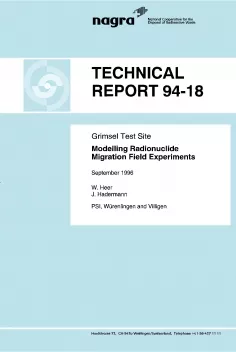
Technical Report NTB 94-18
Grimsel Test Site:Modelling Radionuclide Migration Field Experiments
In the migration field experiments at Nagra's Grimsel Test Site, the processes of nuclide transport through a well defined fractured shear-zone in crystalline rock are being investigated. For these experiments, model calculations have been performed to obtain indications on validity and limitations of the model applied and the data deduced under field conditions.
The model consists of a hydrological part, where the dipole flow fields of the experiments are determined, and a nuclide transport part, where the flow field driven nuclide propagation through the shear-zone is calculated. In addition to the description of the model, analytical expressions are given to guide the interpretation of experimental results.
From the analysis of experimental breakthrough curves for conservative uranine, weakly sorbing sodium and more strongly sorbing strontium tracers, the following main results can be derived:
- The model is able to represent the breakthrough curves of the migration field experiments to a high degree of accuracy. (A simple dual-porosity concept is used describing advective-dispersive transport in narrow water conducting zones and molecular diffusion into stagnant water of the adjacent porous rock zones – matrix diffusion).
- The process of matrix diffusion is manifest through the special shape of the tail ends as well as through the tails of the breakthrough curves, with tracer concentrations decreasing with time as a function of t -3/2; both features are confirmed by the experiments.
- For nuclides which sorb rapidly, not too strongly and linearly, and which exhibit a reversible cation exchange process on fault gouge, the laboratory sorption coefficients can be reasonably well extrapolated to field conditions. Adequate care in selecting and preparing the rock samples is, of course, a necessary requirement.
Using the parameters determined in the previous analysis, predictions are made for experiments in a smaller and faster flow field. The agreement between predicted and measured breakthrough curves is good for the conservative uranine as well as for the weakly sorbing sodium, and still reasonable for the more strongly sorbing strontium – confirming that the model adequately describes the main nuclide transport processes.
The Grimsel radionuclide migration field experiments, performed with an exceptionally high precision, are a useful test of model and data. The modelling results represent an important step in improving the understanding of nuclide transport mechanisms and contribute to increasing confidence in the transport calculations within the framework of safety assessments.
